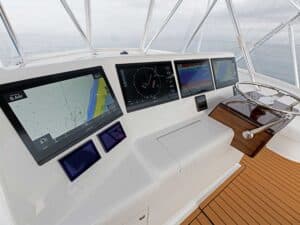
Special delivery: Sign up for the free Marlin email newsletter. Subscribe to Marlin magazine and get a year of highly collectible, keepsake editions – plus access to the digital edition and archives.
As a kid, I was a big fan of Nikola Tesla, the brilliant inventor who gave us amazing technological advancements such as the Tesla coil, alternating-current motor, high-voltage transformer, hydroelectric power, and in total, more than 112 US patents. I liken Elon Musk to a modern-day Tesla, considering some of the extraordinary concepts and ideas Musk has presented, which quickly established himself as one of the most intriguing personalities of the modern era. He is certainly an incredible innovator and visionary, to say the least.
So, when I heard about Starlink, initially I will say that I was intrigued by the simple fact that it was a company owned by Musk, which meant it was something I was interested in learning more about. Then I heard that Starlink was his entry into the maritime market for fast, stable and affordable internet service at sea. My curiosity grew even more.
What Does It Offer?
Like most, I wondered what this new company would do, and how it would differ from others already on the market. Officially, Starlink is a high-speed, low-latency broadband internet service with worldwide coverage. In layman’s terms, it is a new high-speed satellite-based internet provider that has obvious advantages in places such as rural areas and in the middle of the oceans. The coverage area of the SpaceX satellite network is global; it now has approximately 3,660 individual satellites in its constellation as of March 2023.
Starlink has offered fast internet coverage to many areas around the world that previously had limited or no internet options. Aside from mariners, the thousands of islands around the world that were just out of range for internet options are now open for Starlink. It is really just in its infancy, so I would expect more from the company in the maritime department in the future, especially because Starlink is a division of SpaceX, which now owns more satellites in orbit than anyone and is continuing to add to its constellation frequently.
Combine this with the performance of their satellites and the high speeds that they provide for their customers, and it has been truly revolutionary for many. The new system offers the fastest download speeds and is much faster than what was previously available. Maritime users have cheered with up to 220 Mbps download speeds while at sea. Compared with the ViaSat or V-Sat system download speeds—which are reportedly between 20 Mbps and 50 Mbps, depending upon the specific equipment used—Starlink clearly shines.
Cost Comparisons
After comparing the performance comes the next obvious question: How much does this additional speed cost? While I know that many are using the Starlink RV service, which is intended for recreational vehicles and is now called Starlink Roam, I will instead stick to discussing the marine package that Starlink offers. The comparison of costs still favors the Starlink Maritime package, which is $1,000 per month with no data cap. It does require you to purchase the equipment for a one-time fee of $2,500. The two largest marine manufacturers who sell V-Sat systems—Intellian and KVH—also require a one-time equipment purchase, which varies and is well above the Starlink equipment cost.
I will point out that the equipment KVH or Intellian does already offer has a much better design for maritime use, with quality waterproof housings and heavy-duty mounting hardware. Starlink professional installers, as well as do-it-yourself customers, are currently inventing their own mounting configurations out of necessity, as seen on social media. Basically, it is a free-for-all with no real professional solutions for now, but again, I’m sure that will change as the technology evolves.
How are people using this new service? Onboard internet usage varies from surfing the internet to sending and receiving emails to streaming video, and the speeds vary accordingly. This new service allows users to stream video from TV network providers such as YouTube, Hulu and Netflix, to name a few. In the past, this was available but not without constant buffering due to latency issues and slower download speeds.
Read Next: See the latest from our electronics experts here.
Prior to this, other services have offered the ability to stream video at sea via V-Sat, but it was a much higher cost for the data used, which was not unlimited. Starlink is at the top of the mountain for internet at sea for now—especially with uncapped data amounts—and the company has certainly created a lot of buzz recently on social media and the internet. I recently heard of a new entry named Project Kuiper, owned by Amazon, which is gearing up to enter the market with its own rival to Starlink as this issue was going to press. It should be interesting to see what that will bring to the market.
As with nearly every other advancement in technology, these products are sure to become much more powerful and less expensive, with more to offer the end user as they continually evolve. And that’s always a good thing in my book.







